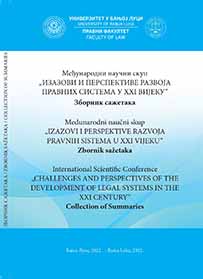ОКО САДРЖАЈА И ПРЕВОДА НОРМЕ О ШТЕТНОМ ИМАЊУ ИЗ ГЛАВЕ 47. ЗАКОНОПРАВИЛА – ПРИЛОГ ПРОУЧАВАЊУ РЕЦЕПЦИЈЕ ПРАВА
ОН THE CONTENT AND TRANSLATION OF THE
NORM ON „STERILE POSSESSION ” FROM CHAPTER 47 OF THE ZAKONOPRAVILO – A CONTRIBUTION TO THE STUDY OF RECEPTION OF LAW
Author(s): Đorđe StepićSubject(s): Law, Constitution, Jurisprudence, History of Law, Civil Law, Middle Ages, Translation Studies, Roman law
Published by: Правни факултет Универзитета у Бањој Луци
Keywords: Zakonopravilo of Saint Sava; church property; reception of law; Justinian’s novels; modern translations;
Summary/Abstract: Until Dušan’s legislative work, the most important general act of the legal system of the Nemanjić state was the Nomocanon, i.e. The Zakonopravilo of Saint Sava. This compendium of secular and ecclesiastical law included Rhomean law, in addition to the “City Law” - Procheiron, and a number of civil law regulations from previous times. The subject of this work will be the beginning of chapter 9 of Justinian’s 120 novella (Nov. 120, 9, pr), which found its way to chapter 47 of the Code of Laws, and which concerns the issue of church property, more precisely - the issue of the issue of the Church acquiring sterile possessions - unprofitable lands. The goal of the research is to point out the various changes made by the redactor by transferring (transplanting) this commandment into Serbian law, as well as the possible reasons for this nomotechnical procedure. On the other hand, the topic will also include the contemporary understanding of the text of the 25th rule in Chapter 47, title 2, ch. 1 of the Zakonopravilo in the light of both previous translations of this work into the modern Serbian language - the translation of Ilovičkо Zakonopravilo and Sarajevsko Zakonopravilo. The purpose of this approach is not only to understand the way of reception to Serbian law, but also to recognize the importance of primary sources and a versatile approach when studying and translating old sources of law.
Journal: Зборник радова Међународни научни скуп „Изазови и перспективе развоја правних система у XXI вијеку"
- Issue Year: 2022
- Issue No: 2
- Page Range: 471-484
- Page Count: 14
- Language: Serbian

